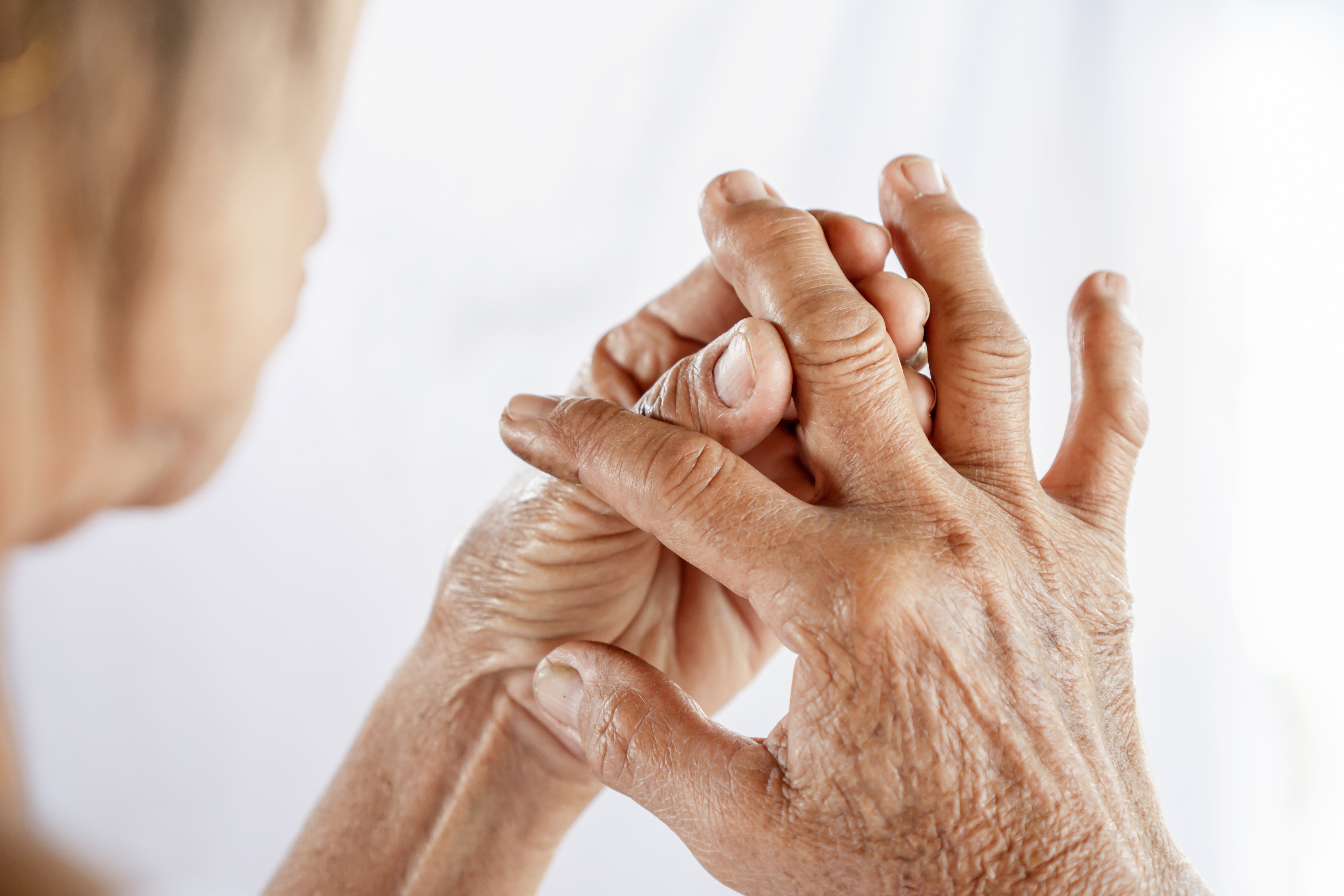General Physician | 9 min read
Rheumatoid Arthritis: Early Sign, Causes, Risk Factor & Complications
Medically reviewed by
Table of Content
Key Takeaways
- Rheumatoid arthritis is an autoimmune disease, which exhibits common characteristics of rheumatism
- Some experts believe that genetic factors may leave you susceptible to infections
- Exercise is mandatory as strengthening the affected areas can prove helpful
When it comes to medical conditions that affect the body, some have a defined cause and some that are categorised as autoimmune diseases. In the latter, the body’s immune mistakenly attacks healthy cells, often resulting in targeted damage to one organ or inflammation in several areas. Rheumatoid arthritis is one such autoimmune disease, which exhibits common characteristics of rheumatism. It means that the patient can experience local inflammation of joints and/or generalised conditions of said joints.
Patients rely upon medical personnel to manage the symptoms of rheumatoid arthritis. Further, for those afflicted with rheumatoid arthritis, it can be quite hard to differentiate the early signs of the disease from those of other conditions. In such cases, being informed about the condition is your best hope, as it points you in the right direction and can push you to get an early diagnosis.
Here are pointers to help you better understand rheumatoid arthritis meaning, its causes, symptoms, diagnosis, and treatment.
What is Rheumatoid Arthritis?
Simply put, rheumatoid arthritis is a systemic, chronic, progressive autoimmune disease. It primarily affects the joints on both sides of the body, but can also cause damage to a range of systems in the body. Here, the inflammation affects the lining of the joints, which then leads to joint deformity and bone erosion. Over time, this inflammation can affect other parts as well and lead to physical disabilities.
Rheumatoid arthritis can occur in four stages.
Stage I
Early rheumatoid arthritis, no damage on X-rays but signs of bone thinning
Stage II
Moderate progressive, minor cartilage damage with possible bone damage, atrophy of muscle, joint mobility issues, and abnormalities in the soft tissue around joints
Stage III
Severe progression, presence of bone thinning and cartilage and joint damage around joint, extensive muscle atrophy, joint deformity but without any permanent stiffness or fixation.
Stage IV
Terminal progression, permanent stiffness or fixation, joint deformity, osteoporosis and bone and cartilage damage around joint, extensive muscle atrophy.
Types of Rheumatoid Arthritis
There are several types of Rheumatic Arthritis, and it is important to know their types to avail the appropriate treatment and ease your discomfort. The types include
Seropositive Rheumatic Arthritis
This is the most common type of Rheumatic Arthritis and runs in the family. If you have seropositive RA, you have a positive rheumatoid factor or anti-CCP blood test result. This indicates that you have the antibodies that drive your immune system to attack the joints. This type of RA includes swelling and pain in multiple joints, including the symmetrical joints, morning stiffness, fever, weight loss, and so on.
Seronegative RA
If you have a negative RF blood test result and a negative anti-CCP result but still experience RA symptoms, you may have seronegative RA. You may ultimately develop antibodies, altering your diagnosis to seropositive RA.
Juvenile Idiopathic Arthritis (JIA)
Juvenile idiopathic arthritis refers to RA detected in children aged 17 and below. This disorder was earlier known as juvenile rheumatoid arthritis (JRA). The symptoms are similar to those of other types of RA, but they may also include eye inflammation and problems with bodily development.
Rheumatoid Arthritis Causes
Some experts believe that genetic factors may leave you susceptible to infections or other factors that may trigger the condition. Once it occurs, the lining of the membranes around the joints known as synovium gets inflamed and thick. This ultimately affects the bone and cartilage of the joint adversely.
As mentioned, there are factors that could increase the risk of developing rheumatoid arthritis. Here is a list of these for reference:
- Family history
- Exposure to asbestos or silica
- Virus infection such as the Epstein-Barr Virus
- Obesity
- Past trauma or injury
- Chronic periodontal disease
- Smoking coupled with family history
- Gender: Women have a higher risk as compared to men
- Age: Middle-aged people are at a higher risk
Early Signs of Rheumatoid Arthritis
Rheumatic Arthritis is a disease that affects individuals differently. However, the early signs may be enough to indicate its arrival; they include:
- Excessive pain in the joint areas, back and muscles
- Stiffness, swelling, tenderness, or weakness in multiple joints of the body
- Loss of consciousness
- Lumps or redness on the skin surface
- Swollen fingers and hands
- Dryness of mouth
- A sensation of pricks or needles on the body
- Bodily deformity
Rheumatoid Arthritis Symptoms
Before learning about the different symptoms that one may experience, it is very important to note that many of these will not persist. With rheumatoid arthritis, it is only during inflammation that the disease is active, and these periods are called flares. Alternatively, these will subside during remission or will present in a much milder form. As per insights from MedicineNet, here are the symptoms you can expect when the disease is active:
- Joint redness
- Low-grade fever
- Joint and muscle pain
- Lack of appetite
- Joint swelling
- Loss of range of motion of joints
- Limping
- Joint deformity
- Loss of joint function
- Joint tenderness
- Rheumatoid nodules
- Anemia
- Frustration
- Depression
- Stiffness
- Fatigue
It is important to note that most of the symptoms linked to muscles or joints may worsen in the morning or after extended periods of inactivity. This is termed post-sedentary stiffness.
What’s the Age of Onset for Rheumatoid Arthritis?
Rheumatic arthritis generally starts to develop between the ages of 30 and 60. But anyone can develop rheumatoid arthritis. In children and young adults — mostly between the ages of 16 and 40 — it is referred to as young-onset rheumatoid arthritis (YORA). In people who develop signs after they turn 60, it is referred to as later-onset rheumatoid arthritis (LORA).
Rheumatoid Arthritis vs Osteoarthritis
Rheumatic Arthritis is an autoimmune condition that results in inflammation in the joints, leading to pain, stiffness, and swelling. Osteoarthritis leads to multiple of the same symptoms as Rheumatic Arthritis but is due to the usual wear and tear of the joints.
While Rheumatic Arthritis normally affects the same joints on both sides of the body, osteoarthritis may only affect one side.
Although other symptoms can assist a person figure out if they are experiencing Rheumatic Arthritis or osteoarthritis, only a physician can diagnose such conditions.
Risk Factors for Rheumatoid Arthritis
There are multiple risk factors for developing rheumatoid arthritis. These include:
- Family history: You are more likely to get rheumatic arthritis if you have a near relative who also has it
- Gender: Women and people declared female at birth are two to three times more certainly to develop rheumatoid arthritis
- Smoking: Smoking increases a person’s chance of rheumatoid arthritis and worsens the condition
- Obesity: Your possibilities of developing rheumatic arthritis are more elevated if you have obesity
Rheumatoid Arthritis Diagnosis
Given the different stages through which this condition progresses, diagnosis can be quite a lengthy process. It will include a battery of tests including X-rays, physical examinations, and even blood tests. Doctors first examine the patient's history and perform a physical check of his/her joints.
During the physical examination, doctors will:
- Look for redness and swelling
- Test your muscle reflexes and strength
- Examine a range of motion and joint function
- Check joints for tenderness and deformity
- Verify the presence of rheumatoid nodules
You may be required to undergo a series of imaging tests to check for joint damage and its severity. Blood tests are also part of the diagnosis. These are of 5 different types:
- Rheumatoid factor test
- Erythrocyte sedimentation rate
- Antinuclear antibody test
- Anticitrullinated protein antibody test
- C-reactive protein test
Rheumatoid Arthritis Treatment
Treating Rheumatic Arthritis includes the consumption of medicines and changes in diet, lifestyle and therapies. Several medications reduce joint pain, swelling, and inflammation and control or slow down the disease. Medicines that treat rheumatoid arthritis include:
- Non-steroidal and non-inflammatory drugs and Cox-2 inhibitors like Ibuprofen, Naproxen, Aspirin, and so on help to reduce pain and inflammation.
- Corticosteroids also reduce pain, discomfort, and inflammation.
- Disease-modifying antirheumatic drugs (DMARDs) Unlike other NSAIDs, DMARDs can defer the disease by modifying your immune system. They include drugs like Methotrexate, Hydroxychloroquine, Sulfasalazine, Leflunomide, and so on.
- JAK inhibitors are another type of DMARD, including Baracitinib, Tofacitinib, and so on.
- If your body does not respond well to DMARDs, your physician may prescribe biologic response agents (biologics). These include Etanercept, Infliximab, Anakinra, Abatacept, Rituximab, and many more.
Rheumatoid Arthritis Complications
Developing Rheumatic Arthritis can also result in several other problems as it drives many complications, such as:
1. Untimely Cardiac Issues
People with Rheumatic Arthritis are more likely to develop heart problems than those without the disease. Those who have obesity and Rheumatis Arthritis are in the greatest danger. Coronary artery disease is the most common cause of death for people who have this disease.
2. Carpal Tunnel Syndrome
Carpal tunnel syndrome is familiar in people with Rheumatic Arthritis. It results in paining, numbness, or pricking in the hands and fingers. It is forced by the contraction of a nerve in the hand called the median nerve.
3. Interstitial Lung Disorder
It is the preliminary pulmonary manifestation of Rheumatis Arthritis and can evolve when your lungs become inflamed.
Pulmonary fibrosis is a disorder that compels lung scarring and stiffness and makes breathing challenging. Pleurisy is another aching lung condition caused due to inflammation of the pleura.
4. Chest Pain
Inflammation of tissues close to your heart can lead to pericarditis, a disease that provokes chest pain.
5. Eye Conditions
Inflammation in the eyes from Rheumatic Arthritis can lead to uveitis and scleritis, which causes eye redness and discomfort.
6. Vasculitis
It is the inflammation of the blood vessels that causes vessels to thicken, weaken, thin, and blotch. In serious cases, it can affect blood flow to your body’s organs and be life-threatening.
7. Joint Damage
Enduring joint damage can occur if Rheumatic Arthritis is not treated early. Joints can become harshly deformed, and nearby tendons, bones, and cartilage can become impaired.
8. Pneumonia
Developing Rheumatic Arthritis increases the chance of developing Pneumonia.
9. Renal Failure
It is another common cause of death in people with Rheumatic Arthritis.
10. Gastrointestinal Hemorrhage
It is a condition where heavy bleeding happens in the upper parts of the digestive tract.
11. Pancytopenia
It is an ailment that occurs when a person loses red blood cells, white blood cells, and platelets from the body. It causes three blood disorders - anemia, leukopenia, and thrombocytopenia.
Managing Chronic Rheumatoid Arthritis
Managing chronic conditions like rheumatoid arthritis can be quite challenging. However, given the fact that remissions are possible and quite frequent for many, these are windows of relief one can enjoy. During such stages, it is absolutely crucial that you do all you can to minimise the damage. Exercise is mandatory as strengthening the affected areas can prove helpful. Else, rheumatoid arthritis can have serious complications like joint deformation. A good way to avoid this is to have the right medical assistance all through and with the healthcare platform provided by Bajaj Finserv Health, you can find the best doctors at your fingertips.
This platform allows you to make the most of technology and healthcare. With it, you can find the best specialists around you and book appointments at their clinics online, minimising the need for multiple physical visits. Moreover, if you need remote care, you can consult with your doctor virtually over video. For conditions like rheumatoid arthritis, this feature can come in handy, especially in the more severe stages. Begin your journey to a healthy life!
References
- https://www.medicinenet.com/rheumatoid_arthritis/article.htm#what_are_rheumatoid_arthritis_symptoms_and_signs
- https://www.medicinenet.com/rheumatoid_arthritis/article.htm#what_are_rheumatoid_arthritis_symptoms_and_signs
- https://www.healthline.com/health/rheumatoid-arthritis#causes
- https://www.medicinenet.com/rheumatoid_arthritis/article.htm#what_are_rheumatoid_arthritis_causes_and_risk_factors
- https://www.mayoclinic.org/diseases-conditions/rheumatoid-arthritis/symptoms-causes/syc-20353648
- https://www.medicinenet.com/rheumatoid_arthritis/article.htm#what_tests_do_physicians_use_to_diagnose_rheumatoid_arthritis
- https://www.medicinenet.com/rheumatoid_arthritis/article.htm
Disclaimer
Please note that this article is solely meant for informational purposes and Bajaj Finserv Health Limited (“BFHL”) does not shoulder any responsibility of the views/advice/information expressed/given by the writer/reviewer/originator. This article should not be considered as a substitute for any medical advice, diagnosis or treatment. Always consult with your trusted physician/qualified healthcare professional to evaluate your medical condition. The above article has been reviewed by a qualified doctor and BFHL is not responsible for any damages for any information or services provided by any third party.



